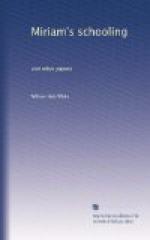Her relief, however, was the relief of stupefaction and not of reconciliation. Sorrow took the form of revolt. It had always been so with her whenever anything was the matter with her: it was the sense of wrong which made it so intolerable. What had she done, she said to herself a hundred times a day, that she should have been betrayed into wretched poverty, that she should have been deserted, and that her fortunes should have been linked with those of an imbecile brother.
Andrew was still very weak—he could hardly speak; and as he lay there impassive, Miriam’s hatred of his silent white face increased. She had too much self-control to express herself; but at times she was almost on the point of breaking out, of storming at him, and asking him whether he had no pity for her. One night, as she sat brooding at the window, and her trouble seemed almost too much for her, and she thought she must give way under it, a barrel organ stopped and began playing a melody from an opera by Verdi. The lovely air wound its way into Miriam’s heart; but it did not console her. It only increased her self-sympathy. She listened till she could listen no longer, and putting her hands over her ears she rested her head upon the table, and was overcome with unconquerable emotion. Poor Andrew stared at her, utterly incapable of comprehending the scene. When she had recovered, he quietly asked her what was the matter.
“Matter!” she cried. “I don’t believe you understand or care any more than the bedstead on which you lie,” and she rose and flung herself out of the house. In those days there was, perhaps there is now, a path—it could not be called a road—from the southern end of London Bridge to Bankside. It went past St. Saviour’s Church, and then trending towards the river, dived, scarcely four feet wide, underneath some mill or mill offices, skirting a little dock which, ran up between the mill walls. Barges sometimes lay moored in this dock, and discharged into the warehouses which towered above it. The path then emerged into a dark trench between lofty buildings connected overhead with bridges, and finally appeared in Bankside amidst heaps of old iron and broken glass, the two principal articles of merchandise in those parts. A dismal, most depressing region, one on which the sun never shone, gloomy on the brightest day. It was impossible to enter it without feeling an instantaneous check to all lightness of heart. The spirits were smitten as if with paralysis directly St. Saviour’s was passed. Thither went Miriam aimlessly that night; and when she reached the dock, the temptation presented itself to her with fearful force to throw herself in it and be at rest. Usually in our troubles there is a prospect of an untried resource which may afford relief, or a glimmer of a distance which we may possibly reach, and where we may find peace, but for Miriam there was no distance, no reserve: this was her first acquaintance with an experience




